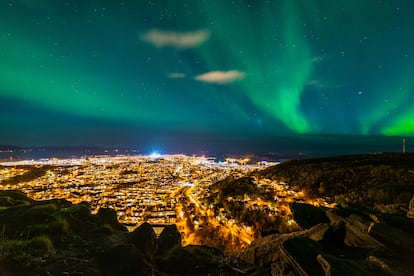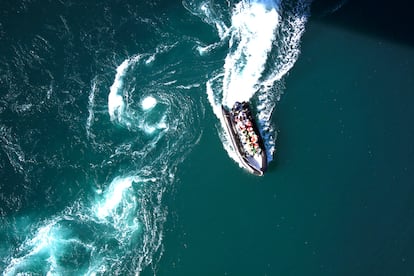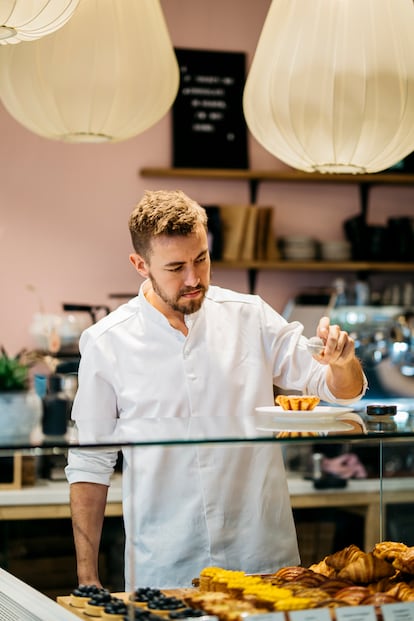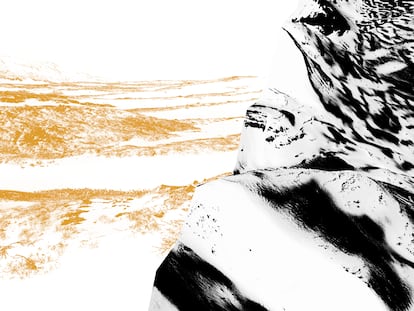Discovering Bodø, the Norwegian city that’s hosting the biggest party in the world
For the first time, a European cultural capital is in the Arctic Circle. In 2024, Bodø — located in the Nordland region of Norway — will offer around 1,000 activities, including the chance to see the northern lights

Six nautical miles south of Bodø — a port in the Norwegian Sea so far north that it’s included within the Arctic Circle — the strongest whirlpool in the world shakes the eight passengers and two crew members. They’re on board the inflatable boat that has entered the strait that separates the islands of Straumen and Straumøya.
This marine safari — contracted from the Explorers Salten agency (at a price of $120) — is, perhaps, the most impressive experience among those that can be enjoyed in Bodø, a coastal city of 50,000 inhabitants. It has been declared one of the three European cultural capitals in 2024, and the first within the Arctic Circle to hold this status under the European Capital of Culture program.
Dressed in thermal suits and equipped with hats, goggles and gloves, we explored the coasts and cold waters of the Norwegian Sea. We sailed for two hours between a small archipelago of snow-covered islands, while escorted by beautiful pairs of white-tailed sea eagles. The landscape in the background was made up of mountains that could be the scene of a Viking saga. In fact, in these parts, there are vestiges of a powerful clan of those indomitable warriors from the north, who preferred suicidal death in combat against the largest army of Saint Olav — the king of Norway who Christianized the country — rather than swapping their gods Thor and Odin for the doctrine of Christ… or so legend has it.
The boat jumps at full speed over good-sized waves, until it’s immersed in the maelstrom, a phenomenon that occurs when a strong sea current (in this case, the one coming from the Gulf of Mexico) penetrates a strait at both ends and forms two branches that flow in opposite directions. When they collide, intense whirlpools are formed. The Saltstraumen maelstrom is considered to be the strongest marine current on the globe. It was in these rough waters that the French writer Jules Verne placed the disappearance of the submarine Nautilus in the final chapter of Twenty Thousand Leagues Under the Sea.
In the capital of the Nordland region, some 1,000 events will be held in the city and across the northern region. Music concerts — from classical to jazz, from rock and roll to the traditional music of the Sami people, who settled in this land 3,500 years ago after arriving from Asia — are fused with dance shows, plays, art exhibitions, gastronomic events, sports and outdoor activities. “The Arctic dimension is an important concept that we wanted to reflect,” says Marit Helene Thoresen, head of communications for Bodø 2024.

The agenda has been divided into five seasons that follow the journey of the sun in the Arctic year: Here Comes the Sun, Spring Optimism, Midsummer Madness, Autumn Storms and Arctic Light. Among the most attractive events is the Sápmi Triennial, which will be held between August 17 and October 6. It will bring together Sami installations, works and artists (or Sápmi, as these Indigenous people call themselves) from Norway, Sweden and Finland in a large-scale exhibition. The transformation of the Municipal Museum into the Sami Museum will be official on April 26, with an exhibition of 200 objects from this culture.
There will be an amazing concert by saxophonist Håkon Skog Erlandsen from the Pluragrotta underwater cave, where the sound technicians, audience members, journalists and 50 musicians must have diving certificates to be able to reach the cave from the depths of the sea on the night of March 16 (the concert will be live-streamed for those above water). Back on land, there will be a controversial exhibition about Nobel Prize-winning author Knut Hamsun (1859-1952), which won’t ignore how his literary legacy was tarnished by his sympathies with the Nazi invaders of Norway during World War II. And of course, there will be the food festival titled Feeding Europe, which will insert various dishes from Arctic cuisine into the global culinary map.
More than half-a-million travelers are expected to visit Bodø and Nordland for what event organizers are calling “the world’s biggest party.” It’s the biggest in terms of duration — with activities and events being held throughout 2024 — but also in setting, as Nordland stretches 500 miles from north to south.
The mystique of cold and snow
In addition to attending this mega-festival of culture and leisure, Bodø itself offers a lot to visitors. The city — endowed with the mystique of cold temperatures, snow and long winters with hardly any sunlight — offers visitors a glimpse of the northern lights, which dance with their colors in the clear night skies, in a kind of magical or psychedelic ceremony. The port city also boasts several original establishments that have sprung up in recent years in the downtown that are worth visiting.
Everything there is to see is just a few minutes walk away from the port area or the city center. On cold autumn and winter afternoons, it’s advisable to stop by Craig Alibone’s beautiful pastry and champagne shop, where Craig himself advises customers on the appropriate glass to accompany a delicious mango and lime cake, a coconut éclair with chocolate, or spiced apple pastry. The chocolates are made in-house, using the best cocoas from different parts of the planet. There’s also the Studio EBN store, with bags, belts, wallets and accessories made from fish skin from the local fish farms, “which otherwise would have been thrown away,” explains Elisabeth Benonisen, designer and owner of the store.

At lunch and dinner time (breakfast will always be a huge buffet in hotels with spectacular architecture, such as the Radisson Blu or the Comfort) the scene has been renewed with restaurants serving up local cuisine, such as Bryggerikaia — where you have to try the fish soup from northern Norway — or, if you opt for a more exotic meal, Ohma, which specializes in Norwegian food with roots in the Asian continent. And, to end the night, you can head to a lively pub, the Sportsbaren, which has a good menu of beers and spirits, where you can also grab a hamburger. It’s a highly-recommended option: very friendly service and very pleasant clientele.
A tour of this beautiful Norwegian region can have an exceptional ending if you jump on one of the ferries that connect Bodø with the beautiful Lofoten Islands, located just a few hours away. But that’s another journey entirely.
Sign up for our weekly newsletter to get more English-language news coverage from EL PAÍS USA Edition
Tu suscripción se está usando en otro dispositivo
¿Quieres añadir otro usuario a tu suscripción?
Si continúas leyendo en este dispositivo, no se podrá leer en el otro.
FlechaTu suscripción se está usando en otro dispositivo y solo puedes acceder a EL PAÍS desde un dispositivo a la vez.
Si quieres compartir tu cuenta, cambia tu suscripción a la modalidad Premium, así podrás añadir otro usuario. Cada uno accederá con su propia cuenta de email, lo que os permitirá personalizar vuestra experiencia en EL PAÍS.
¿Tienes una suscripción de empresa? Accede aquí para contratar más cuentas.
En el caso de no saber quién está usando tu cuenta, te recomendamos cambiar tu contraseña aquí.
Si decides continuar compartiendo tu cuenta, este mensaje se mostrará en tu dispositivo y en el de la otra persona que está usando tu cuenta de forma indefinida, afectando a tu experiencia de lectura. Puedes consultar aquí los términos y condiciones de la suscripción digital.
More information
Archived In
Últimas noticias
The new victims of the Republican war on Obamacare: Millions hit by soaring health insurance premiums
A country divided on migrant rights: Some US states expand protections while others restrict them
Venezuela authorizes the release of another 87 political prisoners
There is as much life left to discover on planet Earth as that which is already known
Most viewed
- David King, chemist: ‘There are scientists studying how to cool the planet; nobody should stop these experiments from happening’
- Reinhard Genzel, Nobel laureate in physics: ‘One-minute videos will never give you the truth’
- Oona Chaplin: ‘I told James Cameron that I was living in a treehouse and starting a permaculture project with a friend’
- Sinaloa Cartel war is taking its toll on Los Chapitos
- The Interoceanic Train, the Mexican alternative to the Panama Canal










































